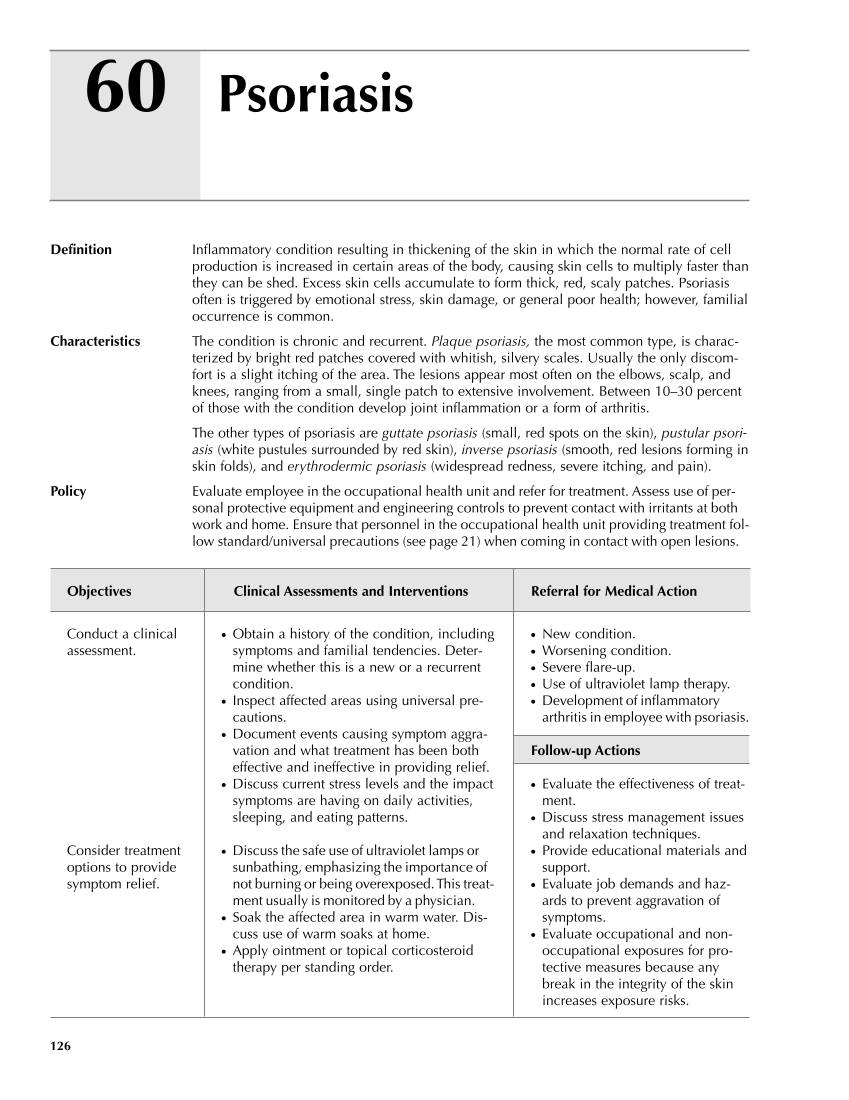60 126 Definition Inflammatory condition resulting in thickening of the skin in which the normal rate of cell production is increased in certain areas of the body, causing skin cells to multiply faster than they can be shed. Excess skin cells accumulate to form thick, red, scaly patches. Psoriasis often is triggered by emotional stress, skin damage, or general poor health however, familial occurrence is common. Characteristics The condition is chronic and recurrent. Plaque psoriasis, the most common type, is charac- terized by bright red patches covered with whitish, silvery scales. Usually the only discom- fort is a slight itching of the area. The lesions appear most often on the elbows, scalp, and knees, ranging from a small, single patch to extensive involvement. Between 10–30 percent of those with the condition develop joint inflammation or a form of arthritis. The other types of psoriasis are guttate psoriasis (small, red spots on the skin), pustular psori- asis (white pustules surrounded by red skin), inverse psoriasis (smooth, red lesions forming in skin folds), and erythrodermic psoriasis (widespread redness, severe itching, and pain). Policy Evaluate employee in the occupational health unit and refer for treatment. Assess use of per- sonal protective equipment and engineering controls to prevent contact with irritants at both work and home. Ensure that personnel in the occupational health unit providing treatment fol- low standard/universal precautions (see page 21) when coming in contact with open lesions. Objectives Clinical Assessments and Interventions Referral for Medical Action Psoriasis ● New condition. ● Worsening condition. ● Severe flare-up. ● Use of ultraviolet lamp therapy. ● Development of inflammatory arthritis in employee with psoriasis. Follow-up Actions ● Evaluate the effectiveness of treat- ment. ● Discuss stress management issues and relaxation techniques. ● Provide educational materials and support. ● Evaluate job demands and haz- ards to prevent aggravation of symptoms. ● Evaluate occupational and non- occupational exposures for pro- tective measures because any break in the integrity of the skin increases exposure risks. Conduct a clinical assessment. Consider treatment options to provide symptom relief. ● Obtain a history of the condition, including symptoms and familial tendencies. Deter- mine whether this is a new or a recurrent condition. ● Inspect affected areas using universal pre- cautions. ● Document events causing symptom aggra- vation and what treatment has been both effective and ineffective in providing relief. ● Discuss current stress levels and the impact symptoms are having on daily activities, sleeping, and eating patterns. ● Discuss the safe use of ultraviolet lamps or sunbathing, emphasizing the importance of not burning or being overexposed. This treat- ment usually is monitored by a physician. ● Soak the affected area in warm water. Dis- cuss use of warm soaks at home. ● Apply ointment or topical corticosteroid therapy per standing order. Guideline continues on next page
Purchased from OEM Press by (ge corporate access). (C) 2013 OEM Health Information, Inc. All rights reserved.












































































































































































































































































































































































































































